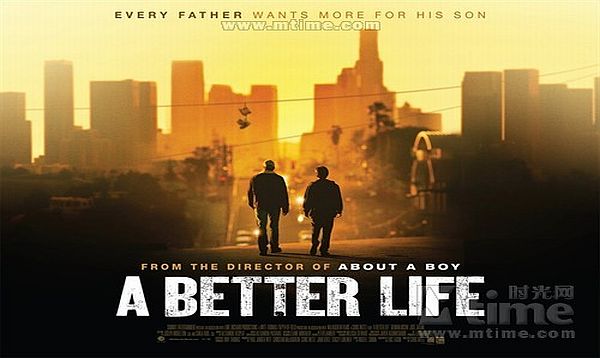Hollywood, CA - Mexican actor Demian Bichir may be well known in his own country, but is relatively unknown across the border in Hollywood. Not for much longer, as the actor goes head-to-head with some of Tinseltown's biggest stars - including George Clooney and Brad Pitt - at the Oscars this year. He's the first Mexican to be nominated for an Academy Award for best actor since Anthony Quinn, who was last nominated in 1964.
"We Mexicans don't have any obstacles to finding a job in Hollywood anymore, it's our talent that counts, not our nationality," Bichir told the BBC. "I hope my nomination leads to more support for Mexican cinema abroad and for more and better movies to be filmed in Mexico."
He is not the only Mexican nominated at the Oscars this year. Emmanuel Lubezki, a Mexican cinematographer, has also received a nod for his work on The Tree of Life.
If a Mexican is successful at this year's awards, it may remind some of the so-called "Golden Age of Mexican Cinema."
In the 1940s and 50s, Mexican cinema enjoyed great success. There were stars such as the dashing actor and singer Jorge Negrete, and the man known as the "Charlie Chaplin of Mexico," Mario 'Cantinflas' Moreno. Sultry leading lady Maria Felix conquered the hearts of millions in the Spanish-speaking world.
Today, Mexico's cinematic stars are a very different breed.
They are directors with international hits such as Guillermo del Toro with Pan's Labyrinth and Hellboy, Alejandro Gonzalez Inarritu with Babel, and Alfonso Cuaron with Harry Potter and the Prisoner of Azkaban.
Actors such as Salma Hayek, Gael Garcia Bernal (The Motorcycle Diaries, Babel), and Diego Luna (Milk) have all achieved success in both Spanish-language cinema and Hollywood. "Mexico has definitely seen an impressive cinema revival over the past decade," The Hollywood Reporter's John Hecht says.
"Production volume has increased, there's more funding available than in the past, and Mexico has a much stronger presence at top-tier film festivals and in the international marketplace. That explains in large part why there are more and more opportunities these days for both emerging and established crossover talents from Mexico."
Mexico is indeed experiencing a boom in national film production, exporting Mexican artists and know-how to other countries as well as welcoming foreign companies to shoot feature films in Mexico. This is why during his recent trips to the United States, Mexican President Felipe Calderón didn't just hold face-to-face talks with President Obama and businessmen, but also Rambo star Sylvester Stallone.
When Mr Calderón met the star in Las Vegas last year, jokes began to circulate on Twitter that the Mexican leader was asking Stallone, or "Rambo's," help in dealing with the country's violent drug cartels. In fact, however, the meeting was part of a concerted push by the Mexican government to boost the country's movie industry.
According to the United Nations, Mexico has the largest creative industry in Latin America, and it is the fourth largest exporter of performing arts among developing countries, selling $361 million (USD) worth of cultural products a year. Indeed the industry is currently doing so well that more than 60 Mexican feature films were released in 2011, the highest in two decades.
The city of Rosarito in the northern state of Baja California might not be the place where the Titanic sank in 1912. But it is where director James Cameron sank his version of the liner in 1997; the city is home to the largest aquatic studios in the world.
In recent years, Mexico has served as the setting for many Hollywood blockbusters, including Pearl Harbor and the Bond film Tomorrow Never Dies. Some recent features filmed here include Colombiana with Zoe Zaldana and Mel Gibson's Get the Gringo.
"Foreign film-makers come here inspired by our creative talent, but also for our facilities and studios," says Jesus Ricardo Alvarez of ProMexico, a government agency seeking more foreign investment in Mexican cinema.
Up to 280 Mexican production companies have sprung up in the last decade, some working on foreign films. Other film-makers who choose to stay in Mexico are also experiencing international attention.
The film Miss Bala is one example. It tells the story of a young woman who dreams of becoming Miss Baja California, but is instead sucked into a world of drug trafficking and organized crime. The film, by director Gerardo Naranjo, premiered at the Cannes Film Festival last year and has since achieved some success with foreign audiences.
It has been screened in 12 countries, so far earning nearly $2 million (USD) at the box office - small by Hollywood standards, but impressive for a modest Mexican film. The success of the film surprised many Mexicans, even those accustomed to the daily stories of drug-related violence dominating the country's headlines.
"Many of these movies that are connecting with audiences in Mexico and abroad describe a contradictory and complicated reality," says producer Martha Sosa. "The new Mexican films know how to tell a very painful reality with great quality and a strong story," she says.
Although the United States, with its huge Hispanic population, is still the main market for Mexican cinema, it is increasingly popular in European countries such as France, Germany, and the UK.
"International festival organizers and film distributors are realizing that these movies are able to communicate with a wider audience," Ms. Sosa says. "They tell universal stories; they just happen to be written and filmed in our backyard."


